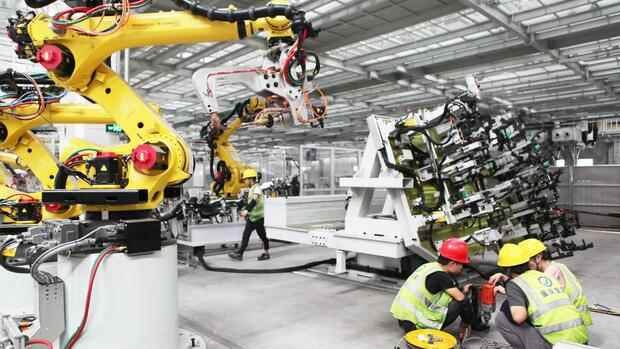Foreign manufacturers such as the Japanese Fanuc Group still dominate the most important robot market in the world.
(Photo: Barcroft Media/Getty Images)
Munich China has been by far the largest market for industrial robotics for years. But foreign manufacturers still dominate the market. The Chinese government wants to change that in the coming years.
Robotics is “the key technology of modern industry,” said Song Xiaogang, secretary-general of the China Robot Industry Alliance (CRIA), on Thursday. That is why China submitted its second robot industry development plan as part of the 14th five-year plan. This has “great importance for the promotion and development of high-quality Chinese robotics,” said the Secretary General.
The market is extremely important for the industry. “China is by far the largest robot market in the world,” said Milton Guerry, president of the International Federation of Robotics (IFR). In 2020, 168,000 robots were newly installed in China. This means that sales have increased by an average of 20 percent in each of the past five years.
Nevertheless, there is still a need to catch up. In terms of robot density – machines per 10,000 employees – China ranks ninth in the world with 246 units. Five years ago, the country came in 25th with 49 robots.
Top jobs of the day
Find the best jobs now and
be notified by email.
For comparison: South Korea is the global leader when it comes to automation with the help of robots. In 2020, there were 932 robots for every 10,000 employees. Germany ranks fourth with 371 units.
ABB, Kuka and Yaskawa have recently been able to maintain their positions
China’s leadership now wants to strengthen the position of domestic suppliers. In recent years, foreign manufacturers such as ABB, Kuka and Yaskawa have largely been able to maintain their strong position.
According to the IFR industry association, the market share of foreign providers was 73 percent – and thus similar to eight years ago. This also includes robots that are produced by Kuka in China for the Chinese market, for example.
Chinese providers such as Efort and Siasun recently delivered a good 45,000 robots in China, which corresponds to a market share of 27 percent. So far, they have played a subordinate role worldwide.
The new five-year plan aims to change that. This is “pioneering for digital development and intelligent modernization in China and also contributes to promoting the global progress of robot technology,” said CRIA association secretary Song Xiaogang.
The takeover of the German robot manufacturer Kuka by the Chinese household appliance group Midea five years ago also caused a stir. The Chinese want to take the Augsburg company off the stock exchange soon. The goal is “market leadership in the highly dynamic robotics and automation industry,” said Andy Gu, Chairman of the Supervisory Board. The Chinese robot manufacturer Estun, in turn, took over the German welding technology specialist Carl Cloos a good two years ago.
Years of record hunting
After years of chasing records, the robotics industry initially suffered from the corona pandemic. Car manufacturers in particular, who are still the most important buyers of heavy industrial robots for welding, for example, were reluctant to invest.
That changed a long time ago. Despite the shortage of chips and raw materials, the industry association IFR recently expected sales to increase by around 13 percent to 435,000 robots sold for the first time in 2021.
The industry is also anticipating further growth in the coming years. According to this, half a million robots could be sold for the first time in 2024.
More: How Saxony wants to become the leading robotics cluster
